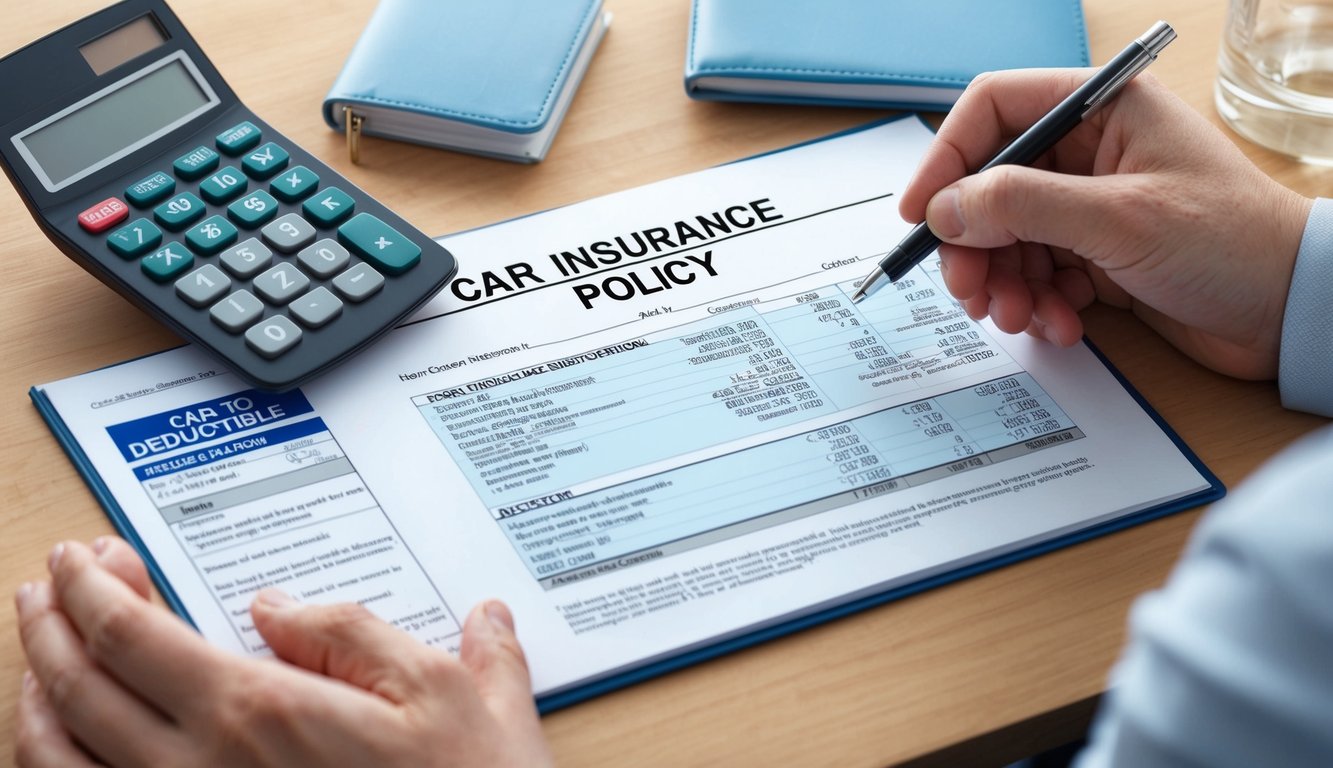Car insurance premiums can be a significant expense for many drivers.
Understanding how your deductible affects your rates is crucial for managing your auto insurance costs effectively.
Adjusting your deductible can lead to substantial savings on your car insurance premiums. This article will explore the relationship between deductibles and premiums, providing practical tips to help you find the right balance for your budget and risk tolerance.
1) Understand your current deductible
Your car insurance deductible is the amount you agree to pay out of pocket before your insurance coverage kicks in.
It’s crucial to know your current deductible to evaluate if it’s the right fit for your financial situation.
Check your insurance policy documents or contact your insurance provider to find out your current deductible amount.
Typical deductibles range from $250 to $1,000, but they can vary.
You might have different deductibles for various types of coverage.
For example, your comprehensive coverage deductible might differ from your collision coverage deductible.
Understanding your deductible helps you assess your potential out-of-pocket expenses in case of an accident or claim.
It’s the starting point for determining if adjusting your deductible could lead to lower car insurance premiums.
Consider how your current deductible aligns with your budget and risk tolerance.
A higher deductible usually means lower premiums, while a lower deductible typically results in higher premiums.
Review your claims history to see how often you’ve needed to use your insurance.
This can help you decide if a change in your deductible makes sense based on your past experiences.
2) Evaluate your financial situation
Before adjusting your car insurance deductible, take a close look at your finances.
Consider your savings, monthly income, and expenses.
Determine how much you could comfortably pay out of pocket in case of an accident.
Review your emergency fund.
A robust savings account can support a higher deductible.
If you have limited savings, a lower deductible might be more suitable.
Assess your risk tolerance.
Are you comfortable with potentially paying more in the event of a claim? If so, a higher deductible could work for you.
Examine your driving habits and history.
If you’re a cautious driver with a clean record, you might feel more confident choosing a higher deductible.
Consider your vehicle’s value.
For older cars with lower values, a high deductible might not make sense.
In contrast, newer, more expensive vehicles could benefit from higher deductibles.
Factor in your monthly budget. Increasing your deductible can lower your premium payments.
Calculate how much you could save and decide if it’s worth the trade-off.
Think about your future financial plans.
If you anticipate major expenses or changes in income, factor these into your decision.
Your ability to cover a higher deductible may change over time.
3) Compare insurance providers
Shopping around for car insurance can lead to significant savings.
Insurance rates vary widely between companies, so comparing quotes is essential.
Get quotes from multiple insurers to find the best deal.
Online comparison tools make this process quick and easy.
You can compare rates from many companies side-by-side to see which offers the lowest premium for your desired coverage.
Don’t limit yourself to just the big national insurers.
Local and regional companies may offer competitive rates.
Sometimes smaller insurers provide more personalized service or unique discounts.
When comparing, make sure you’re looking at equivalent coverage levels.
A lower price isn’t always better if it means less protection.
Pay attention to deductibles, coverage limits, and included features.
Consider factors beyond just price.
Look at each company’s customer service ratings, claims process, and financial stability.
A slightly higher premium might be worth it for better service or faster claims handling.
Remember that insurance rates change regularly.
It’s wise to shop around for new quotes every 6-12 months or before your policy renewal.
You might find a better deal, especially if your circumstances have changed.
Don’t hesitate to ask your current insurer to match a competitor’s lower rate.
They may offer additional discounts to keep your business.
4) Increase your deductible gradually
Raising your car insurance deductible can be an effective way to lower your premiums.
However, it’s wise to take a gradual approach rather than making a drastic change all at once.
Start by increasing your deductible by a small amount, such as $100 or $250.
This allows you to gauge the impact on your premium without significantly altering your financial risk.
Monitor your savings over time.
If you’re comfortable with the new deductible and the premium reduction, consider another small increase after 6-12 months.
Remember to assess your financial situation before each increase.
Ensure you can comfortably afford the higher out-of-pocket cost in case of an accident.
Keep in mind that the relationship between deductible increases and premium reductions isn’t always linear.
The savings percentage may decrease as you reach higher deductible levels.
By taking a step-by-step approach, you can find the optimal balance between your deductible and premium that suits your budget and risk tolerance.
5) Review your policy annually

Scheduling a yearly review of your car insurance policy is crucial for maintaining optimal coverage and potentially lowering your premiums.
Insurance needs can change over time, and staying proactive allows you to adjust your policy accordingly.
During your annual review, take a close look at your current deductible.
If you’ve built up savings since last year, you might be in a position to increase your deductible. Higher deductibles can lead to lower premiums, potentially saving you money in the long run.
Check if your driving habits have changed.
Maybe you’re working from home more often or have moved closer to your workplace.
These changes could qualify you for a low-mileage discount, reducing your insurance costs.
Review any life changes that occurred in the past year.
Getting married, improving your credit score, or completing a defensive driving course can all positively impact your insurance rates.
Don’t forget to reassess the value of your vehicle.
As cars depreciate, you may be able to adjust your coverage levels, particularly for older vehicles.
This could result in lower premiums without sacrificing necessary protection.
Lastly, use this annual review as an opportunity to shop around and compare quotes from different insurers.
Even if you’re satisfied with your current provider, exploring other options can help ensure you’re getting the best possible rate.
6) Ask for multi-policy discounts

Insurers often reward customers who purchase multiple policies from them.
This practice is known as bundling.
You can potentially save an average of 14% on your homeowners and auto insurance by bundling these policies with one company.
Consider combining your car insurance with other types of coverage you may need.
This could include homeowners, renters, or life insurance.
Many insurers offer discounts for bundling multiple policies.
When shopping for insurance, ask about multi-policy discounts.
Compare the bundled rates from different companies to find the best deal.
Remember that the cheapest option isn’t always the best – ensure the coverage meets your needs.
If you already have insurance with one company, inquire about adding additional policies.
You might find significant savings by consolidating your insurance needs with a single provider.
Some insurers offer discounts for insuring multiple vehicles on the same policy.
If you have more than one car in your household, ask about multi-vehicle discounts.
Keep in mind that bundling isn’t always the best option.
In some cases, you might find better rates by using different insurers for different policies.
Always compare the total cost and coverage before making a decision.
7) Maintain a good credit score

Your credit score can significantly impact your car insurance premiums.
Insurance companies often use credit-based insurance scores to assess risk and determine rates.
A higher credit score generally translates to lower insurance costs. Having good credit could potentially lower your car insurance costs.
This is because insurers view individuals with better credit as less likely to file claims.
To improve your credit score, focus on paying bills on time and reducing your overall debt.
Keep your credit card balances low and avoid applying for new credit unnecessarily.
Regularly check your credit report for errors.
If you find any inaccuracies, dispute them promptly with the credit bureaus.
Consider setting up automatic payments for your bills to avoid late payments.
This simple step can help maintain a positive payment history.
The same principle applies to car insurance rates.
By maintaining a good credit score, you demonstrate financial responsibility to insurers.
This can lead to more favorable premium rates and potentially significant savings on your car insurance.
8) Take advantage of low mileage discounts

Driving less can lead to significant savings on your car insurance.
Many insurers offer low mileage discounts for those who don’t spend much time behind the wheel.
If you work from home or have a short commute, you might qualify for these discounts.
Typically, insurers consider low mileage to be under 7,500 to 10,000 miles per year.
Some insurance companies use telematics devices or mobile apps to track your mileage.
These tools can provide accurate data to your insurer, potentially leading to better rates.
Consider carpooling, using public transportation, or biking for short trips to reduce your annual mileage.
This not only helps you save on insurance but also reduces wear and tear on your vehicle.
If you have multiple cars, try to use the more fuel-efficient one for longer trips.
This can help keep the mileage low on your other vehicles.
Remember to inform your insurance provider if your driving habits change.
A significant reduction in your annual mileage could lead to immediate savings on your premiums.
Some insurers offer pay-per-mile insurance, where your rate is based on how much you actually drive.
This can be an excellent option if you rarely use your car.
By taking advantage of low mileage discounts, you can potentially reduce your car insurance costs while maintaining the coverage you need.
9) Consider usage-based insurance

Usage-based insurance programs offer a way to potentially lower your car insurance premiums based on your driving habits.
These programs typically use telematics devices or smartphone apps to track your driving behavior.
By opting for usage-based insurance, you allow your insurer to monitor factors such as your mileage, speed, acceleration, and braking patterns.
Safe driving habits and low mileage can lead to significant savings on your premiums.
Many insurers provide immediate discounts just for enrolling in their usage-based programs.
As you demonstrate responsible driving over time, you may qualify for additional premium reductions.
Keep in mind that these programs measure various aspects of your driving.
They typically track speeding, acceleration, harsh braking, and the time of day you drive.
Your insurer will use this data to calculate your driving score and determine your premium.
If you’re a safe driver who doesn’t rack up many miles, usage-based insurance could be an excellent option for you.
However, if you frequently drive long distances or during high-risk hours, this type of insurance might not result in savings.
Before enrolling, carefully review the terms of the program.
Understand what data will be collected and how it will impact your rates.
Also, consider any privacy concerns you may have about sharing your driving data with your insurance company.
10) Look for accident forgiveness options

Accident forgiveness is a valuable feature offered by many car insurance companies.
It can help protect you from rate increases after your first at-fault accident.
With accident forgiveness, your insurer agrees not to raise your premium following your first accident claim.
This benefit can save you money in the long run, especially if you have a clean driving record.
Many major insurers provide accident forgiveness options.
For example, Geico’s accident forgiveness protects you from premium increases after your first at-fault accident.
The specifics of accident forgiveness programs vary between insurers.
Some companies include it automatically for long-term customers with clean records.
Others offer it as an add-on feature for an additional cost.
To find out if you qualify for accident forgiveness, contact your insurance provider directly.
Ask about eligibility requirements and how to add this coverage to your policy.
Keep in mind that accident forgiveness typically applies only once.
After using it, you’ll need to maintain a clean record for a certain period to regain eligibility.
While accident forgiveness can be beneficial, it’s not always the most cost-effective option.
Compare the cost of adding this feature to your potential savings in case of an accident.
Long-Term Costs
A higher deductible lowers premiums, but it also increases your out-of-pocket expenses if you file a claim.
You’ll need to pay more before your insurance coverage kicks in.
This can be particularly challenging if you’re involved in a major accident or your vehicle suffers significant damage. Unexpected repair costs could strain your finances if you’re not prepared to cover the higher deductible.
Consider your financial stability and ability to pay a larger sum in case of an accident.
If you can’t easily afford the higher deductible, the short-term premium savings might not be worth the risk.
It’s crucial to maintain an emergency fund that can cover your deductible amount to avoid financial stress in the event of a claim.






